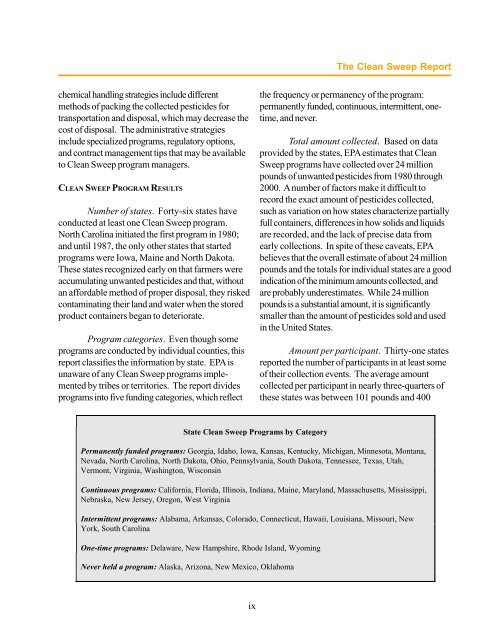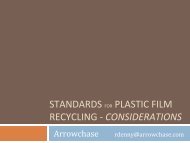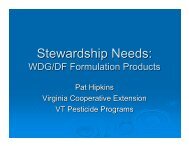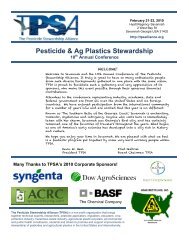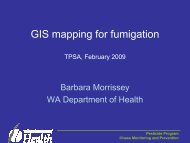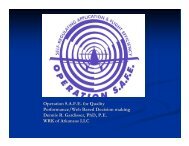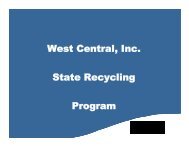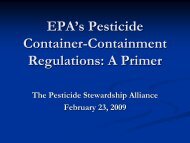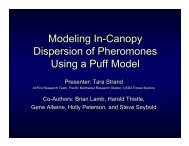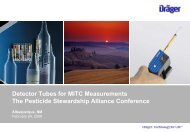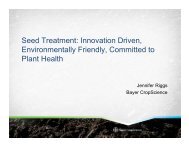Clean Sweep Programs - US Environmental Protection Agency
Clean Sweep Programs - US Environmental Protection Agency
Clean Sweep Programs - US Environmental Protection Agency
- No tags were found...
You also want an ePaper? Increase the reach of your titles
YUMPU automatically turns print PDFs into web optimized ePapers that Google loves.
The <strong>Clean</strong> <strong>Sweep</strong> Reportchemical handling strategies include differentmethods of packing the collected pesticides fortransportation and disposal, which may decrease thecost of disposal. The administrative strategiesinclude specialized programs, regulatory options,and contract management tips that may be availableto <strong>Clean</strong> <strong>Sweep</strong> program managers.CLEAN SWEEP PROGRAM RESULTSNumber of states. Forty-six states haveconducted at least one <strong>Clean</strong> <strong>Sweep</strong> program.North Carolina initiated the first program in 1980;and until 1987, the only other states that startedprograms were Iowa, Maine and North Dakota.These states recognized early on that farmers wereaccumulating unwanted pesticides and that, withoutan affordable method of proper disposal, they riskedcontaminating their land and water when the storedproduct containers began to deteriorate.Program categories. Even though someprograms are conducted by individual counties, thisreport classifies the information by state. EPA isunaware of any <strong>Clean</strong> <strong>Sweep</strong> programs implementedby tribes or territories. The report dividesprograms into five funding categories, which reflectthe frequency or permanency of the program:permanently funded, continuous, intermittent, onetime,and never.Total amount collected. Based on dataprovided by the states, EPA estimates that <strong>Clean</strong><strong>Sweep</strong> programs have collected over 24 millionpounds of unwanted pesticides from 1980 through2000. A number of factors make it difficult torecord the exact amount of pesticides collected,such as variation on how states characterize partiallyfull containers, differences in how solids and liquidsare recorded, and the lack of precise data fromearly collections. In spite of these caveats, EPAbelieves that the overall estimate of about 24 millionpounds and the totals for individual states are a goodindication of the minimum amounts collected, andare probably underestimates. While 24 millionpounds is a substantial amount, it is significantlysmaller than the amount of pesticides sold and usedin the United States.Amount per participant. Thirty-one statesreported the number of participants in at least someof their collection events. The average amountcollected per participant in nearly three-quarters ofthese states was between 101 pounds and 400State <strong>Clean</strong> <strong>Sweep</strong> <strong>Programs</strong> by CategoryPermanently funded programs: Georgia, Idaho, Iowa, Kansas, Kentucky, Michigan, Minnesota, Montana,Nevada, North Carolina, North Dakota, Ohio, Pennsylvania, South Dakota, Tennessee, Texas, Utah,Vermont, Virginia, Washington, WisconsinContinuous programs: California, Florida, Illinois, Indiana, Maine, Maryland, Massachusetts, Mississippi,Nebraska, New Jersey, Oregon, West VirginiaIntermittent programs: Alabama, Arkansas, Colorado, Connecticut, Hawaii, Louisiana, Missouri, NewYork, South CarolinaOne-time programs: Delaware, New Hampshire, Rhode Island, WyomingNever held a program: Alaska, Arizona, New Mexico, Oklahomaix


